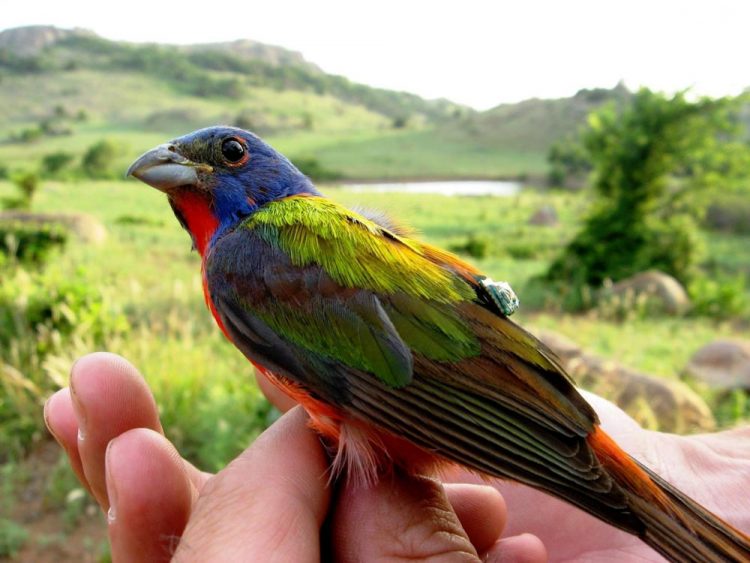OU research team identify genetic structure of Painted Bunting

An OU research team has identified the genetic structure of the Painted Bunting and can now differentiate between the eastern and western Painted Bunting and identify the species pattern of migration and population of origin. Credit: University of Oklahoma
“We combine molecular genetic research and conservation biology to differentiate between Painted Bunting populations and individual birds that migrate across several countries for breeding in the United States during the summer, then migrate to Central America for wintering where often they are captured and sold in the international avian pet market,” said Contina, a National Science Foundation, National Research Traineeship postdoctoral fellow. “Genetic markers allow us to differentiate where the birds come from after they are sold.”
Contina and team members from the Oklahoma Biological Survey; OU Department of Biology; Colegio de Postgraduados, Mexico; Department of Ecology and Evolutionary Biology at the University of California Santa Cruz; and University of California Los Angeles are working in collaboration to better understand why certain Painted Bunting populations are declining.
The genetic research conducted by the inter-institutional team has international relevance and can be used in future investigative studies.
The Painted Bunting breeds primarily in the United States during the summer and migrates to Mexico, Central America, southern Florida and the Caribbean over the winter.
Male Painted Buntings are brightly colored, which makes them highly sought after as pets, particularly in Mexico, Central America and Europe.
Pet market birds examined in the published study are most likely from the Central breeding population in the United States. One bird can sell for as much as $800 in the international avian pet market.
###
An OU research paper, “Genetic structure of the Painted Bunting and its implications in conservation of migratory population,” has been published in IBIS–International Journal of Avian Science. Support for this research is provided by the National Science Foundation (Grant Nos. IDBR 1014891 and DEB 0946685) and the United States Department of Agriculture (Grant No. NIFA-AFRI-003536).
Media Contact
All latest news from the category: Life Sciences and Chemistry
Articles and reports from the Life Sciences and chemistry area deal with applied and basic research into modern biology, chemistry and human medicine.
Valuable information can be found on a range of life sciences fields including bacteriology, biochemistry, bionics, bioinformatics, biophysics, biotechnology, genetics, geobotany, human biology, marine biology, microbiology, molecular biology, cellular biology, zoology, bioinorganic chemistry, microchemistry and environmental chemistry.
Newest articles

NASA: Mystery of life’s handedness deepens
The mystery of why life uses molecules with specific orientations has deepened with a NASA-funded discovery that RNA — a key molecule thought to have potentially held the instructions for…

What are the effects of historic lithium mining on water quality?
Study reveals low levels of common contaminants but high levels of other elements in waters associated with an abandoned lithium mine. Lithium ore and mining waste from a historic lithium…

Quantum-inspired design boosts efficiency of heat-to-electricity conversion
Rice engineers take unconventional route to improving thermophotovoltaic systems. Researchers at Rice University have found a new way to improve a key element of thermophotovoltaic (TPV) systems, which convert heat…



